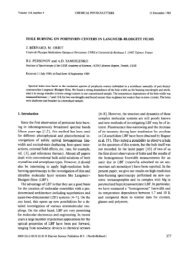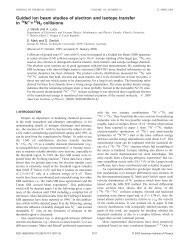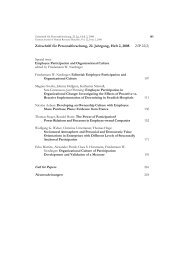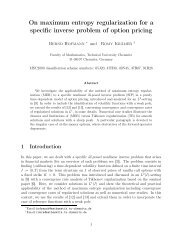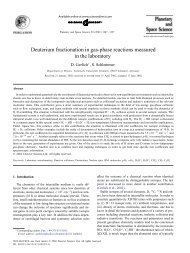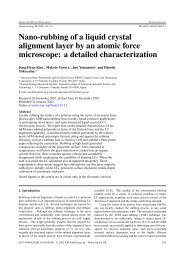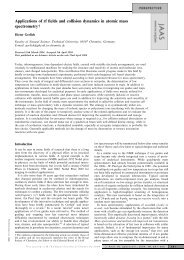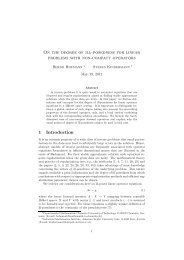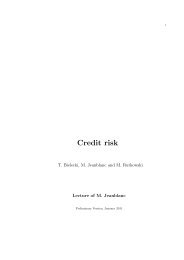On the nature of ill-posedness of an inverse problem arising in option
On the nature of ill-posedness of an inverse problem arising in option
On the nature of ill-posedness of an inverse problem arising in option
You also want an ePaper? Increase the reach of your titles
YUMPU automatically turns print PDFs into web optimized ePapers that Google loves.
<strong>On</strong> <strong>the</strong> <strong>nature</strong> <strong>of</strong> <strong>ill</strong>-<strong>posedness</strong> <strong>of</strong> <strong>an</strong> <strong><strong>in</strong>verse</strong> <strong>problem</strong> <strong>aris<strong>in</strong>g</strong> <strong>in</strong> <strong>option</strong> pric<strong>in</strong>g 1329<br />
4. Solv<strong>in</strong>g <strong>the</strong> outer equation <strong>of</strong> <strong>the</strong> IP <strong>in</strong> L p -spaces for noisy <strong>option</strong> data<br />
In this section we measure deviations <strong>of</strong> <strong>the</strong> functions u δ <strong>an</strong>d S δ from u <strong>an</strong>d S on <strong>the</strong><br />
<strong>in</strong>terval [0, T ]byme<strong>an</strong>s <strong>of</strong> L p -norms. We consider <strong>the</strong> B<strong>an</strong>ach spaces B2 = L q (0, T ) <strong>an</strong>d<br />
B3 = L p (0, T ) with 1 � p, q < ∞ for <strong>the</strong> outer equation (16) <strong>of</strong> <strong>the</strong> IP.<br />
The positive data function u δ (t)(0 � t � T ) <strong>of</strong> observed maturity-dependent <strong>option</strong><br />
prices is not necessarily smooth <strong>an</strong>d arbitrage free <strong>in</strong> <strong>the</strong> sense <strong>of</strong> assumptions 3.1 <strong>an</strong>d 3.3, but<br />
it satisfies assumption 4.1.<br />
Assumption 4.1. The non-negative data function uδ ∈ Lq approximated by <strong>the</strong> estimate<br />
(0, T ) (1 � q < ∞) is<br />
�u δ − u�L q (0,T ) � δ (27)<br />
<strong>the</strong> fair <strong>option</strong> price function u = F(a) = N(S) for a given noise level δ>0. Moreover, let<br />
a ∈ L∞ (0, T ) hold for <strong>the</strong> volatility function, where we assume <strong>an</strong> upper bound ¯c � �a�L ∞ (0,T )<br />
imply<strong>in</strong>g 0 � S(t) � κ(0� t � T ) with κ := ¯cT.<br />
We apply a vari<strong>an</strong>t <strong>of</strong> <strong>the</strong> method <strong>of</strong> quasisolutions exploit<strong>in</strong>g <strong>the</strong> fact that<br />
D κ + :={˜S ∈ D+ :0� ˜S(t) � κ(0� t � T ), ˜S(t1) � ˜S(t2) (0 � t1 < t2 � T )}<br />
is a compactum <strong>in</strong> <strong>the</strong> B<strong>an</strong>ach space L p (0, T )(1 � p < ∞) (see, e.g., [4, example 3, p 26]).<br />
As <strong>an</strong> approximate solution <strong>of</strong> <strong>the</strong> outer equation (16) we use a quasisolution associated with<br />
<strong>the</strong> data uδ ,whichisam<strong>in</strong>imizer Sδ ∈ Dκ + <strong>of</strong> <strong>the</strong> extremal <strong>problem</strong><br />
�N( ˜S) − u δ �L q (0,T ) −→ m<strong>in</strong>, subject to ˜S ∈ D κ + .<br />
Then we c<strong>an</strong> prove <strong>the</strong> follow<strong>in</strong>g convergence assertion.<br />
Theorem 4.2. Let {Sδn ∞ } n=1 be a sequence <strong>of</strong> quasisolutions associated with a sequence <strong>of</strong><br />
data {uδn ∞ } n=1 satisfy<strong>in</strong>g <strong>the</strong> <strong>in</strong>equality (27), where δn → 0 as n →∞.Then<strong>the</strong> convergence<br />
properties<br />
lim<br />
n→∞ �Sδn − S�L p (0,T ) = 0 (1 � p < ∞) (28)<br />
<strong>an</strong>d<br />
lim<br />
n→∞ �Sδn − S�L ∞ (0,γ ) = 0 for all 0




